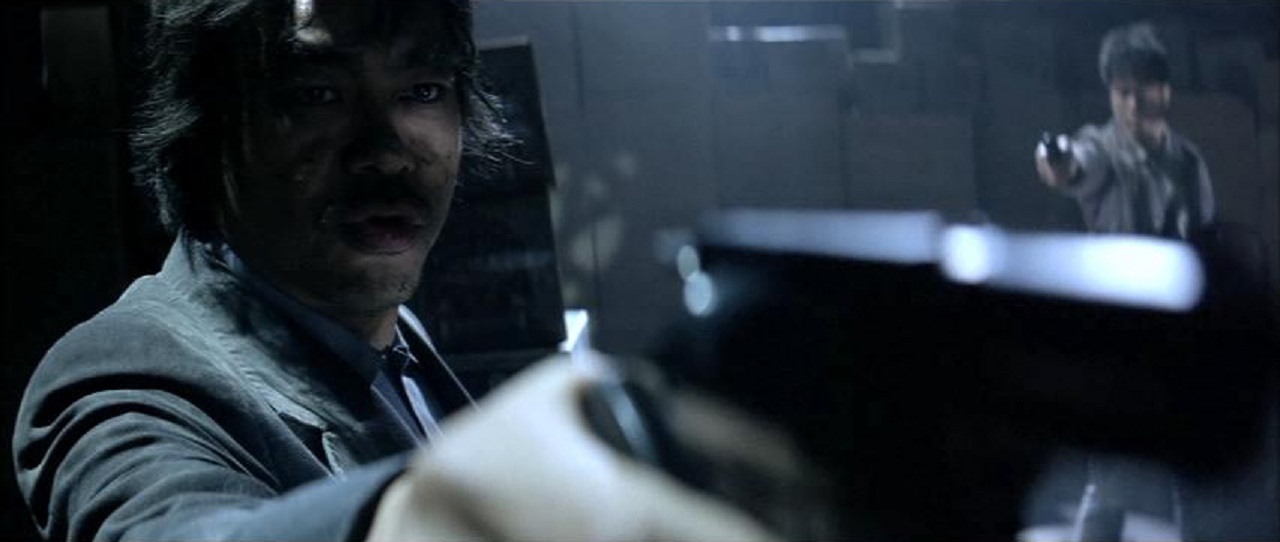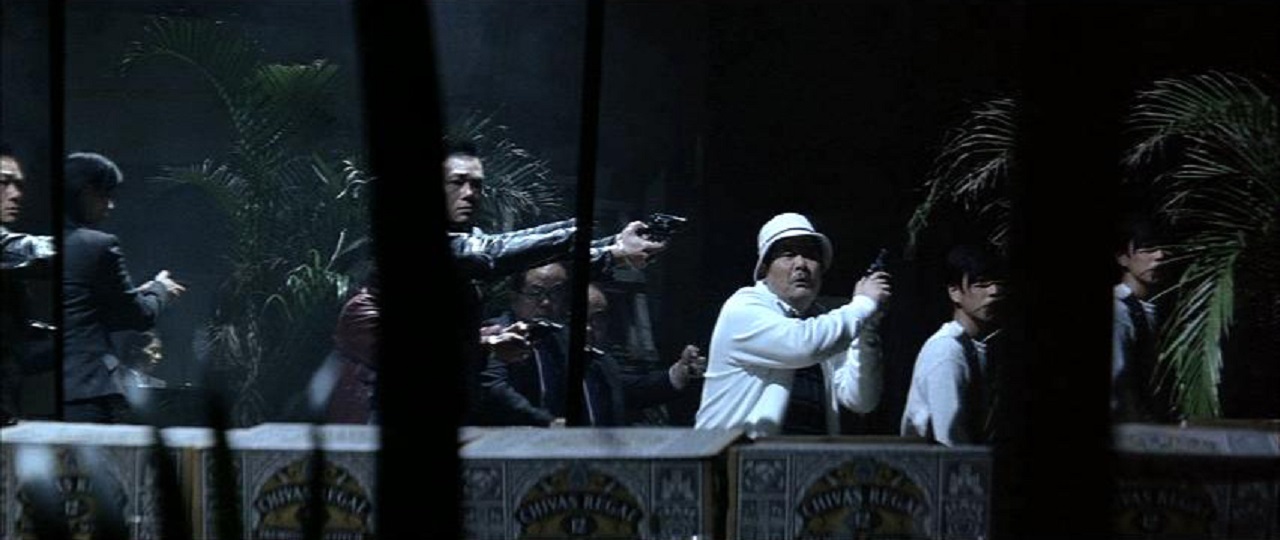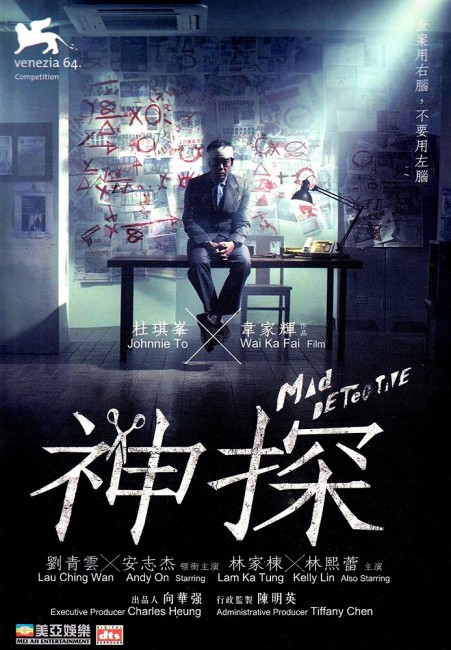(Sun Taam)
Crew
Directors/Producers – Johnnie To & Wai Ka Fai, Screenplay – Au Kin Yee & Wai Ka Fai, Photography – Cheng Siu Keung, Music – Xavier Jamaux, Optical Effects Coordinator – Wong Lai Kuen, Production Design – Raymond Chan. Production Company – Milkyway Image (HK) Ltd/One Hundred Years of Film Co, Ltd.
Cast
Lau Ching Wan (Bun), Andy On (Inspector Ho Ka On), Lam Ka Tung (Ko Chi Wai), Kelly Lin (May Cheung), Lee Kwok Lun (Wong Kwuk Chu), Lam Suet (Ko’s Inner Fat Man), Lau Kam Ling (Ko’s Inner Businesswoman), Karen Lee (Gigi), Flora Chan (May Cheung in Bun’s Eyes), Cheung Siu Fai (Ko’s Inner Violent Man), Jonathan Lee (Ho’s Inner Boy), Wong Wah Wo (Restaurant Manager)
Plot
Police detective Ho goes to see the retired inspector Bun to ask his help. Ho has been unable to solve the case of fellow detective Wong who went missing while on a stakeout. To add to the mystery, Wong’s gun has subsequently been used in several armed robberies. Bun has a reputation for his remarkably intuitive ability in solving cases, although is regarded as crazy by others. Bun’s wife does not want him to go but he does. Bun starts following detective Ko Chi Wai, who was Wong’s partner on the night he went missing. Ho gradually becomes aware that Bun is able to see someone’s inner personality. Bun claims that Ko has seven inner personalities, some of which are dangerous and violent. As they follow the convoluted trail involving Ko, the vanished Wong and the mystery gun, Ho comes to believe that Bun may indeed be crazy. Among other things, Bun talks and reacts to his wife who is not there. However, Bun also makes a remarkable series of deductions about what happened to Wong and the gun due to his ability to absorb and replay past events.
Wai Ka Fai is a unique voice in Hong Kong cinema who has gained a modest name over the last decade. Wai began directing with the Western Peace Hotel (1995) and then went onto the fascinating alternate timelines gangster film Too Many Ways to Be No. 1 (1997). Most of Wai Ka Fai’s work has been made in collaboration with Johnnie To. They have had a number of hits including the romantic comedy Love on a Diet (2001) and the gangster film Fulltime Killer (2001), as well as Mad Detective here. The two have versatility in a variety of genres and have ventured into fantastic material on a number of occasions including:- Help!!! (2000), a black comedy set in a hospital that has some fantasy elements; the comedy Wu Yen (2001) about mischievous fairies; My Left Eye Can See Ghosts (2002), a comedy about a woman who starts to see ghosts after an accident; Running on Karma (2003), which is similar to Mad Detective in its story of a Buddhist monk with the ability to see people’s past lives; Fantasia (2004) about a wizard drawn through time to contemporary Hong Kong; Himalaya Singh (2005), a Magical Realist comedy involving amnesia drugs; and the meta-fictional Written By (2009) where a dead man is reincarnated in an alternate life in his daughter’s novel. Since then, they have dropped back to Johnnie directing and Wai writing and producing his films.
One can honestly say that Mad Detective is the most demented Hong Kong film that one has seen in some time – maybe ever. It is a film that requires the totality of a viewer’s attention and that one’s ability to follow detail be as agile as a tap dancer – doze or let your attention wander and you will miss the lightning-paced shifts of perspective between one shot and the next. You have no idea what is going on for some time into the film. In the opening moments, for instance, Lau Ching Wan does a Vincent Van Gogh and gruesomely slices off his ear and hands it to his boss as a present. (You are not entirely sure what this gesture has to do with the rest of the film as it is only vaguely referred to again). This is followed by utterly bizarre moments like where Lau Ching Wan is brought back to the force for a briefing during which a woman appears to start screaming insults at him before Lau gets up and abruptly head butts her, as all the while she disconcertingly shifts back and forward between the woman and a male detective.
Similarly, when Lau and Andy On start following the other detective (Lam Ka Tung) through the streets, he appears in different shots to shift between a single person walking along and a group of people walking in unison, even turning in accord to see who is following them. Lau and Andy On follow Lam to a restaurant and watch where he becomes a sweaty overweight man (Lam Suet) eating his dinner, while we also see a woman (Lau Kam Ling) standing behind telling him what to say. This bizarreness culminates in a scene where Lau Ching Wan follows Lam into the bathroom, stands beside him at the urinal and then turns and pisses on his leg. We bewilderingly see Lam alternating places with the fat man and even the woman who is hilariously seen standing at the urinal with her skirt lifted and a stream of urine coming out just like a man, before it erupts in violence and all seven people are standing over Lam trying to prevent him from using his gun.

It is only gradually through this that we start to piece together clues to what is going on – that Lau Ching Wan can see the inner personality (each of the people that appear being a different personality) and the directors are deliberately flipping between the subjective point of view of what Lau sees when he looks at a person and the objective external view that everybody else gets. One needs to watch the film very closely as Wai and Johnnie To alternate these viewpoints without any clear signposting and then later start twisting this into a wilful disorientation.
The film becomes increasingly more head-spinning. Next, Wai and To set up a scene – one where they seem to be almost parodying the criminal profiler characters of tv shows like Millennium (1996-9) and Profiler (1996-2000) – where Lau Ching Wan re-enacts an armed heist and the scene disconcertingly flips back and forth between violently charged scenes of the masked robbers holding up convenience stores and shooting people and Lau acting these out and going “pow pow” with his pointed finger like a kid playing cops’n’robbers.
The most mind-bending scene is where Lau Ching Wan and Andy On go out to a restaurant for dinner and bring their respective wives. Lau seems attentive and loving to his wife and the reactions of everyone else are appropriate to this, only for the restaurateur to suddenly reveal that the wife does not exist but how Lau comes here every day and brings ‘her’ with him. There is even an amazing scene where Lau Ching Wan takes the wife for a ride on Andy On’s motorcycle and the viewpoint disconcertingly switches back and forward between seeing her cuddled up to him on the back of the bike and wide-angles of him driving down the street alone.

Mad Detective becomes vastly entertaining for the considerable ingenuity that Wai Ka Fai and Johnnie To have in playing with the point-of-view flips and the twists that they keep putting on this. One of the most ingenious scenes is when, having given us the impression that Lau’s wife only exists in his mind, they then have the real wife appear – and for Lau Ching Wan to not recognise the woman he sees. A positively ingenious scene ensues in Lau’s car, involving the wife alternating between the real woman we have seen, the shrewish person Lau sees in his head and his imaginary wife sitting in the backseat – at one point, the real wife turns to have an angry argument with the imaginary woman.
There is a wonderfully stylish climax involving the various parties meeting in a shootout in a warehouse that has a hall of mirrors – one that allows Wai and To to flip back and forward between showing the actors stalking and shooting one another and shots of their inner personalities doing so in the mirrors. There is one marvellous shot that shows Lam Ka Tung standing holding a gun amid the broken shards of mirror on the floor in which all of the inner personalities are reflected aiming guns. The last shot of the film is a witty little coda with Andy On swapping the various stolen guns back and forward between the dead bodies as he tries to decide how best to present the evidence. There has not been another film in some time that has led such an ingenious dance with its audience.
(Winner in this site’s Top 10 Films of 2007 list. Nominee for Best Original Screenplay at this site’s Best of 2007 Awards).

